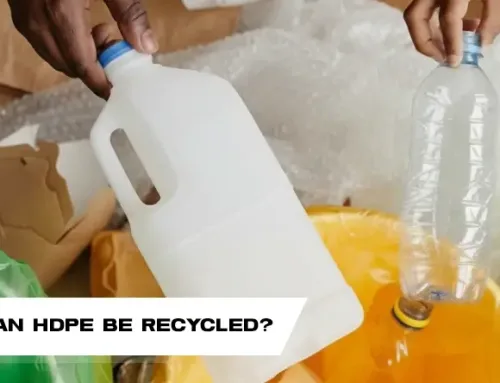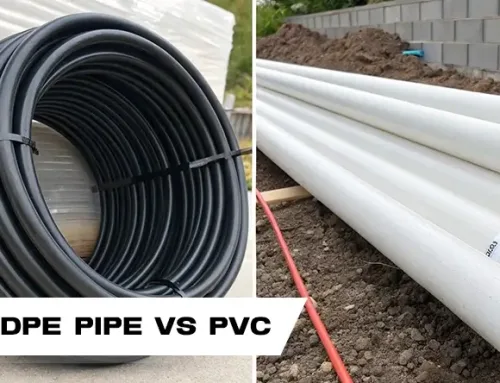High-Density Polyethylene (HDPE) is a name synonymous with durability. As a robust, versatile thermoplastic polymer, it’s recognized globally for its high strength-to-density ratio, appearing in everything from milk jugs to industrial chemical tanks. But when the application moves from the pantry or the factory floor to the backyard or a construction site, a crucial question arises: Can HDPE be used outdoors?
The answer is a definitive yes, but with an important qualification. While base HDPE is a formidable material, its long-term success in an outdoor environment hinges entirely on specific formulations and the inclusion of critical additives. Without them, the very same material that can safely contain corrosive acids would fail under the relentless assault of the sun.
This guide will serve as a comprehensive analysis of HDPE’s performance in outdoor settings. We will explore its inherent properties that make it a superior choice for harsh conditions, investigate its one major limitation—sensitivity to ultraviolet (UV) light—and detail the precise manufacturing solutions that overcome it. Finally, we will examine its most common and transformative outdoor applications, from long-lasting furniture to critical infrastructure, to provide a complete picture of its capabilities.
Why HDPE is the Preferred Material for Long-Lasting Outdoor Applications
Before addressing its limitations, it’s essential to understand why High-Density Polyethylene is so frequently chosen for outdoor use. Its fundamental material properties provide a baseline of performance that many traditional materials, like wood or metal, simply cannot match. This makes it an ideal, low-maintenance, and cost-effective solution for applications demanding weather resistance.
Resilience to Moisture, Mold, and Rot
HDPE’s primary advantage in any weather-exposed setting is its relationship with water—or lack thereof. The material has extremely low water absorption, making it effectively waterproof. Unlike wood, which will absorb moisture, swell, warp, and eventually rot, HDPE is non-porous.
This non-porous nature means that water, fungus, mildew, and bacteria cannot penetrate its surface. This single property eliminates a host of common outdoor material failures:
- No Rot or Decay: HDPE does not biodegrade or rot, giving it a lifespan decades longer than untreated wood.
- No Mold or Mildew: While mildew can grow on any surface grime, it cannot embed itself in the plastic and is easily washed away.
- No Warping or Swelling: The material remains dimensionally stable whether in a dry desert or a humid, rainy climate.
Superior Strength-to-Density and Impact Resistance
HDPE is famous for its high strength-to-density ratio. This means it is incredibly strong and rigid for its weight, making it easier to handle and install than heavier materials like concrete or thick metal, without sacrificing durability.
Its molecular structure also imparts exceptional impact resistance. This is crucial for outdoor applications where materials face abuse from:
- Rough Handling: Public-use furniture, trash receptacles, and construction materials.
- Environmental Stress: Hail, falling branches, or heavy loads (e.g., snow).
- Vandalism: HDPE won’t easily break, crack, or shatter, reducing replacement frequency and maintenance costs.
Chemical Resistance and Food Safety
HDPE is a stalwart in the chemical industry for a reason. It is exceptionally resistant to a wide range of chemicals, including acids, bases, and many solvents. This translates to superior outdoor performance where materials might be exposed to:
- Cleaning Agents: Bleach or pressure-washing solutions.
- Pool Chemicals: Chlorine and muriatic acid.
- Environmental Pollutants: Acid rain or spills.
Furthermore, many grades of HDPE are approved by the FDA for food contact (e.g., cutting boards). This inherent safety and inertness make it a reliable and non-toxic choice for consumer goods and containers.
Environmental and Financial Benefits
From both a cost and sustainability perspective, HDPE presents a strong case.
- Recyclability: HDPE is (Recycle #2) and one of the most easily and widely recycled plastics, contributing to a circular economy. Many outdoor products, especially “poly lumber,” are made from high percentages of post-consumer recycled HDPE.
- Cost-Effective: While some specialized grades have a higher initial cost, HDPE is relatively inexpensive to produce. Its longevity and low-maintenance nature provide a significantly lower total cost of ownership compared to materials that require frequent replacement, painting, or sealing.
- Low-Maintenance: This is perhaps its greatest financial benefit. HDPE requires no painting, staining, sealing, or waterproofing. It does not rust, chip, or peel. A simple cleaning with soap and water is all that is needed to maintain its appearance.
The Crucial Factor: Mitigating HDPE’s Limited UV Resistance
With all these advantages, HDPE sounds like the perfect outdoor material. However, it has one significant vulnerability: ultraviolet radiation. This is the critical piece of information that separates a successful outdoor application from a catastrophic failure.
Understanding UV Sensitivity in Base HDPE
The base resin of High-Density Polyethylene is UV sensitive. If a standard, non-treated piece of HDPE plastic sheet (like a natural-colored cutting board) were left in direct sunlight, it would begin to degrade. Prolonged exposure to UV radiation attacks the polymer’s chemical bonds.
This process, known as UV degradation, causes the material to:
- Lose its impact strength and become brittle.
- Develop surface-level micro-cracks.
- “Chalk,” or form a dusty, powdery layer as the material breaks down.
- Fade or change color.
This disadvantage is a known property, and for any reputable manufacturer of outdoor-grade HDPE, it has been completely solved.
The Role of UV Stabilizers in Outdoor Grades
This limitation is fully mitigated by incorporating UV stabilizers during the production process. These additives are mixed directly into the molten resin before it is formed, becoming an integral part of the material.
The material used for outdoor furniture or HDPE plastic sheet is treated with UV-inhibiting stabilizers to prevent fading, discoloration, and structural degradation. There are several types of stabilizers, but they generally work in two ways:
- UV Absorbers: These additives (a common one being Carbon Black) absorb the UV radiation and harmlessly dissipate it as a small amount of heat. This is why black HDPE pipe and geomembranes are so common and have a service life of 50+ years.
- Hindered Amine Light Stabilizers (HALS): These are the standard for non-black, colored plastics (like outdoor furniture). HALS do not absorb UV light; instead, they act as radical scavengers. They actively trap and neutralize the high-energy free radicals created by UV radiation, stopping the degradation chain-reaction before it can damage the polymer.
This is why it is critical to source HDPE from a reputable supplier and specify that it is for an outdoor application. A “general purpose” sheet will fail, whereas a “UV-stabilized outdoor grade” sheet will perform for decades.
Major Outdoor Applications of HDPE Plastic Sheet and Materials
When properly formulated with UV stabilizers, HDPE is a high-performance material used across a vast range of demanding outdoor applications.
Manufacturing Premium Outdoor Furniture (Poly Lumber)
One of the most visible applications of HDPE is in HDPE poly lumber, a category of products made from high-density polyethylene, which is often recycled. Brands like POLYWOOD® have built an entire industry on this material.
The benefits for furniture are a direct extension of the material’s properties:
- All-Weather Performance: It is non-porous, highly durable, and won’t suffer damage from insects, mold, or rotting.
- Color-Fast: The color and UV stabilizers are compounded throughout the material, not just on the surface. It will not fade, and scratches will not reveal a different color underneath.
Compared to traditional materials, HDPE outdoor furniture is often superior:
- vs. Wood (Teak, Cedar): Requires zero staining or sealing to maintain its weather resistance, whereas wood requires constant upkeep.
- vs. Aluminum or Steel: Won’t rust like steel or get dangerously hot to the touch like aluminum. It also won’t dent or chip paint.
- vs. PVC Wicker: HDPE is structurally stronger, more impact-resistant, and will not become brittle and unravel over time as PVC wicker often does.
While HDPE poly lumber may have a higher initial cost than cheap PVC furniture, it lasts significantly longer and is easier to recycle, making it a more valuable and sustainable long-term investment.

Critical Infrastructure: Piping and Conduits
The piping industry relies heavily on UV-stabilized (often black) HDPE. Its strength, chemical resistance, and low water absorption make it ideal for:
- Water and Sewage Systems: HDPE pipe is flexible, corrosion-proof, and can be joined by heat-fusion to create monolithic, leak-proof systems. This is a massive advantage over concrete or iron pipes, which are brittle and have joints that can leak or allow root intrusion.
- Gas Pipes: Its durability and leak-proof nature make it the standard for natural gas distribution.
- Electrical and Data Conduits: It protects critical cabling underground from moisture, chemicals, and impact.

Construction and Environmental Engineering
In large-scale civil and environmental projects, HDPE is a critical component.
- Plastic Lumber: Beyond furniture, HDPE plastic lumber is used in decking, fencing, and marine applications (docks, retaining walls) where contact with water and soil would destroy wood.
- Geomembranes: HDPE geomembranes are massive, impermeable sheets of plastic used as liners for ponds, canals, and, most critically, landfills and mining operations. Their job is to contain liquids and prevent hazardous waste from leaching into the groundwater. This application is perhaps the ultimate testament to HDPE’s chemical resistance and long-term durability.

Reviewing the Drawbacks and Limitations of Using HDPE Outside
A balanced article must address all potential drawbacks. While most are mitigated in high-quality outdoor grades, they are important to understand in the context of material selection.
Environmental Stress Cracking (ESC)
HDPE can be prone to Environmental Stress Cracking (ESC). This is not a failure of the material on its own, but a specific phenomenon that occurs when the material is under long-term mechanical stress (like from a bolt being over-tightened) and simultaneously exposed to certain chemical agents (like some detergents or alcohols). High-quality pipe and sheet grades are specifically engineered with high ESC-resistance to prevent this.
Flammability Concerns
While HDPE is more resistant to ignition than some plastics, it is still a thermoplastic and is flammable if exposed to a sufficient heat source or open flame. It is not “fireproof.” For applications requiring higher fire safety, flame retardant additives can be incorporated during manufacturing to meet specific building codes.
Temperature Performance (Addressing the Contradiction)
This is a common point of confusion. Generic, standard-grade HDPE can show low-temperature sensitivity and become brittle in extremely cold environments (e.g., below -20°F or -30°C).
However, this is another property that is specifically engineered for the application. High-grade outdoor sheets and HDPE poly lumber are manufactured to resist this. By using specific copolymers or formulations, these materials are designed to remain rigid and ductile, maintaining their impact strength even in freezing weather, preventing them from becoming brittle.
Conclusion: The Clear Choice for Outdoor Durability
So, can High-Density Polyethylene be used outdoors? The answer is unequivocally yes, but only when you are using the correct grade of HDPE.
When formulated with the necessary UV stabilizers, HDPE is not just a viable choice; it is often the optimal one. Its unparalleled combination of weather resistance, durability, chemical inertness, and low-maintenance longevity makes it a superior material for everything from long-lasting outdoor furniture to critical environmental containment. By understanding its one key weakness and the manufacturing solution that resolves it, you can confidently specify HDPE for your most demanding outdoor projects.







Leave A Comment